Burial of Indian Muslim soldiers of the First World War in England — Contemporary historical reports
|
During the First World War, wounded soldiers
of the British Indian army from fronts in France and Belgium were sometimes removed to England for treatment and recovery in military hospitals. For Muslim soldiers who died while in England, their funeral and burial arrangements were discussed by the British government with the Imam of the Woking Mosque so that they may be carried out according to Islamic custom as well as for the convenience of Muslims.
First burial
The Islamic Review of December 1914 reported on the first such burial, reproducing the report from the Woking Herald. It took place on Monday 9th November 1914. The report is as follows:
“Indian Soldier Buried at Woking
The first burial in this country of an Indian soldier who has died as a result of wounds received while serving with the Indian Expeditionary Force at the front took place in the Mohammedan Cemetery at Brookwood on Monday afternoon. He was Ahmad Khan, of the 3rd Sappers & Miners, and he died on board a transport while on the way from France to Netley Hospital, on November 4. On Saturday the body was conveyed to the Woking Mosque in a motor hearse, the coffin being enshrouded in a Union Jack. The community of Muslims at the Mosque made arrangements with the Necropolis Company for the interment, which was not largely attended, chiefly on account of the fact not being generally known, but most of the Mohammedans at Woking were present, amongst them being an Arab from Medina, the burial place of the Prophet Mahomet. The brief and simple ceremony, which was conducted by Maulvie Sadr-ud-Din, consisted chiefly of silent prayer, interspersed with recitals of the glory of God. The coffin was first placed on the ground by the side of the grave, the Muslims facing towards Mecca during the prayer. After interment, and when the grave had been enclosed, silent prayer was again engaged in. On the coffin were placed several floral tributes from Woking friends — viz., Mrs. R. H. Howell, Mrs. Walters, Mrs. Chambers, and Mrs. Welch.”
(The Islamic Review, December 1914, p. 534)
Below is a photograph of the gravestone of Ahmad Khan, mentioned in the report above as the first Indian Muslim soldier of the First World War to be buried in England. (Photograph taken on 13 November 2014 by Administrator of website www.wokingmuslim.org)
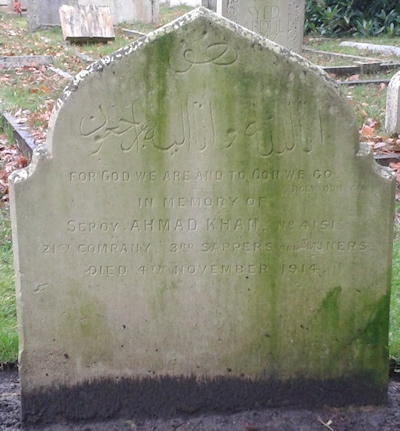
Imam discusses cemetery location with the War Office
Another news item in the same issue is reported as follows:
“The Maulvie Sadr-ud-Din, of the Woking Mosque, was invited by Colonel Lucas, C.B, to the Victoria Royal Hospital, Netley, to approve of a site for opening an Islamic cemetery in the grounds of the hospital, where Indian wounded soldiers are being nursed. The Maulvie did not like the idea of opening a cemetery there, and suggested that it should be set up at Woking, which is the centre of the Muslim community, and where obsequies can be performed satisfactorily in his presence. The Colonel agreed, and asked Colonel Sharaman to accompany the Maulvie to the War Office and India Office, where the question could be discussed and finally settled. Gen. Sir A. Keogh and Gen. Sir Edmund Barrow received the Maulvie Sadr-ud-Din, and discussed the question with him, and decided finally to follow the suggestion offered. Accordingly officers from the War Office called three times at the Mosque, Woking, to prosecute the project. A site along the bank of a canal, some five hundred yards from the Mosque, has been pointed out, where it is hoped that the contemplated Islamic cemetery will be opened.
Further suggestions were submitted to the War Office, which elicited the following reply:—
From THE SECRETARY, War Office, London, S.W., November 12, 1914.
To THE MAULVIE SADR-UD-DIN, B.A., B.T., The Mosque, Woking.
Sir,— I am commanded by the Army Council to thank you for your letter of the 9th inst., relative to the proposed cemetery for Muslim soldiers at Woking, and to inform you that the question of selecting a site on the land north of the railway and canal, which you inspected with Captain H. C. Cole on the 8th inst., is receiving urgent consideration of the Department. The owner has been approached in the matter, and his reply is awaited.
I am to add that you will be kept informed of the action taken, and will be further consulted when the actual site is decided upon.
—I have the honour to be, Sir, your most obedient servant,
(Signed) B.B. CUBITT”
(The Islamic Review, December 1914, p. 532–533)
Detailed Urdu reports by Maulana Sadr-ud-Din
A detailed report of Maulana Sadr-ud-Din’s above-mentioned visit to the Royal Victoria Hospital at Netley and to the War Office in London was written by him in Urdu and published in the Lahore Ahmadiyya periodical Paigham Sulh, in its issue of 29 November 1914. A little later, a report by him, covering the first burials at Brookwood, purchase of land at Horsell, and problems of wounded Indian soldiers, appeared in the 5 January 1915 issue of the same periodical. We present a translation of these reports at this link.
Discussion at Woking local authority meeting
Discussion of this issue at a meeting of the Urban Council in Woking is also reported in The Islamic Review, December 1914, from the Woking Herald as follows:
“The proposed opening of a Mohammedan Cemetery at Woking, more particularly for the burial of Indian soldiers who die in this country as a result of having been in action at the front, was mentioned at a meeting of the Urban Couneil on Tuesday.
The Chairman (Mr. A. H. Godfrey) announced (as exclusively reported in the Herald last week) that the War Office were taking steps to provide a burial ground for Indian troops, and it was considered it should be within a reasonable distance of the Mosque. It was possible that a part of Horsell Common on the northern side of the canal, and on the eastern boundary of the urban area, might be acquired for the purpose. There was nothing official at present before the Council, but a War Office representative had seen some of the Council officials, although the War Office had full powers to do exactly what they liked without consulting the Council. The reason for providing the cemetery was because very grievous lies and false reports were being spread by the Germans amongst the Indian troops as to the manner in which we were dealing with the Mohammedan wounded and dead; it was of the utmost importance that the conscientious scruples of Indian troops should be carefully observed and every consideration given to them. He was sure they would agree that it was almost an honour to have men who fell as a result of the war buried in the district. (Hear, hear.)
Mr. J. B. Walker said that the Necropolis Company were asked to sell a piece of ground in Maybury opposite the Mosque for the purpose of a burial ground, but as it was in the midst of a residential district the company would not consider the proposal under any consideration. He might further tell them that there was already a special burial ground where Mohammedans had been buried in the past in the orthodox manner. He told the War Office that was a rnost suitable place; every facility was offered, and it was not a question of cost, and he still thought that instead of having a separate burial ground on a common it would have been wiser and more convenient to use the ground at Brookwood.
The Chairman said he understood that the head of the community at the Mosque had absolute power in the matter, and it rested with him; it seemed he preferred this particular spot rather than going to Brookwood. He had been informed that Indian princes were to assemble at Woking one day during the week and view the site.
The matter then dropped.”
(The Islamic Review, December 1914, p. 533)
Later history
At first, burials took place at Brookwood, as the one mentioned above under First Burial. From sometime in 1915, they started taking place at Horsell Common. A news item in The Times, 18 April 1916 (p. 5), throws further light on this. Given below is its image:
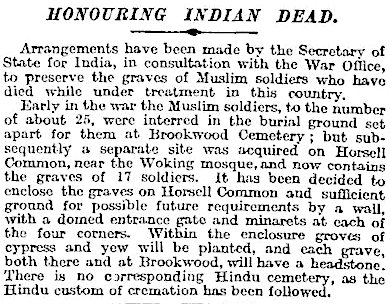
Much later, in the 1960s, the graves at Horsell Common were also re-located to Brookwood.
For further information see our page: History of the Muslim Burial Ground at Horsell Common founded in 1915
Shown below are photographs of gravestones of other soldiers buried in the same row as Ahmad Khan. His grave is the right-most in this row. Photos shown below start from the grave to the immediate left of Ahmad Khan’s, and move to the left one by one.. (Photographs taken on 13 November 2014 by Administrator of website www.wokingmuslim.org).
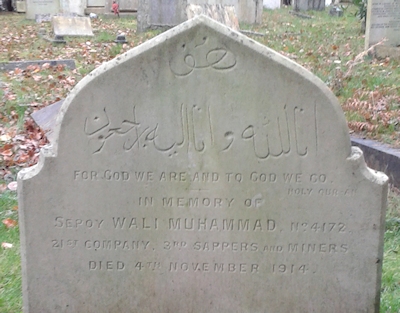
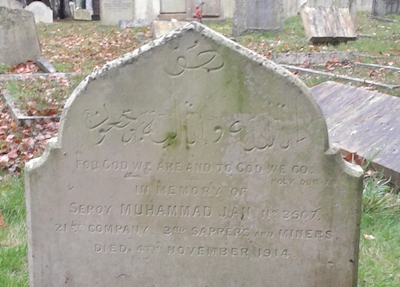
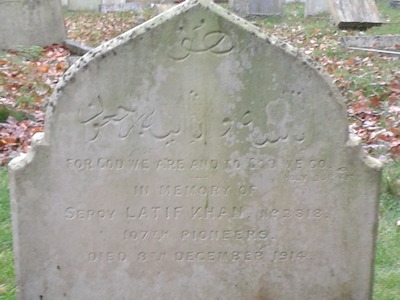
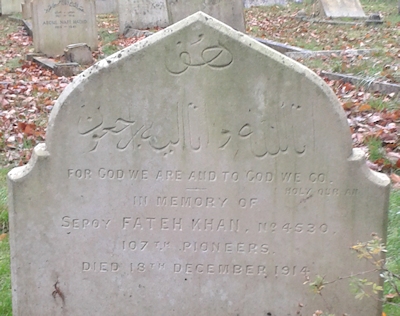
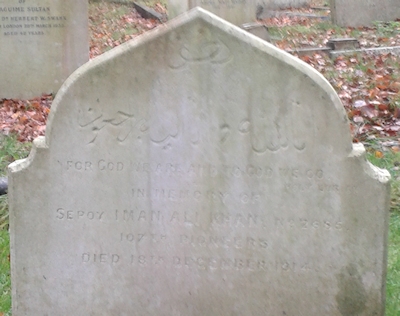
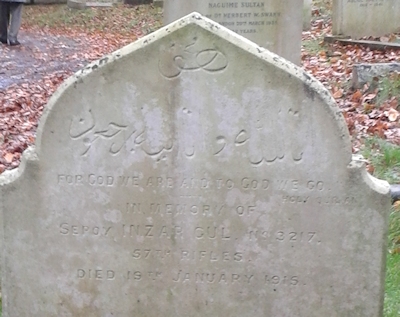
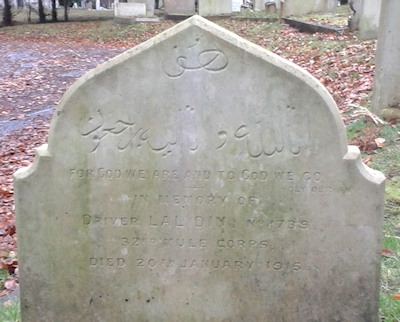
|








